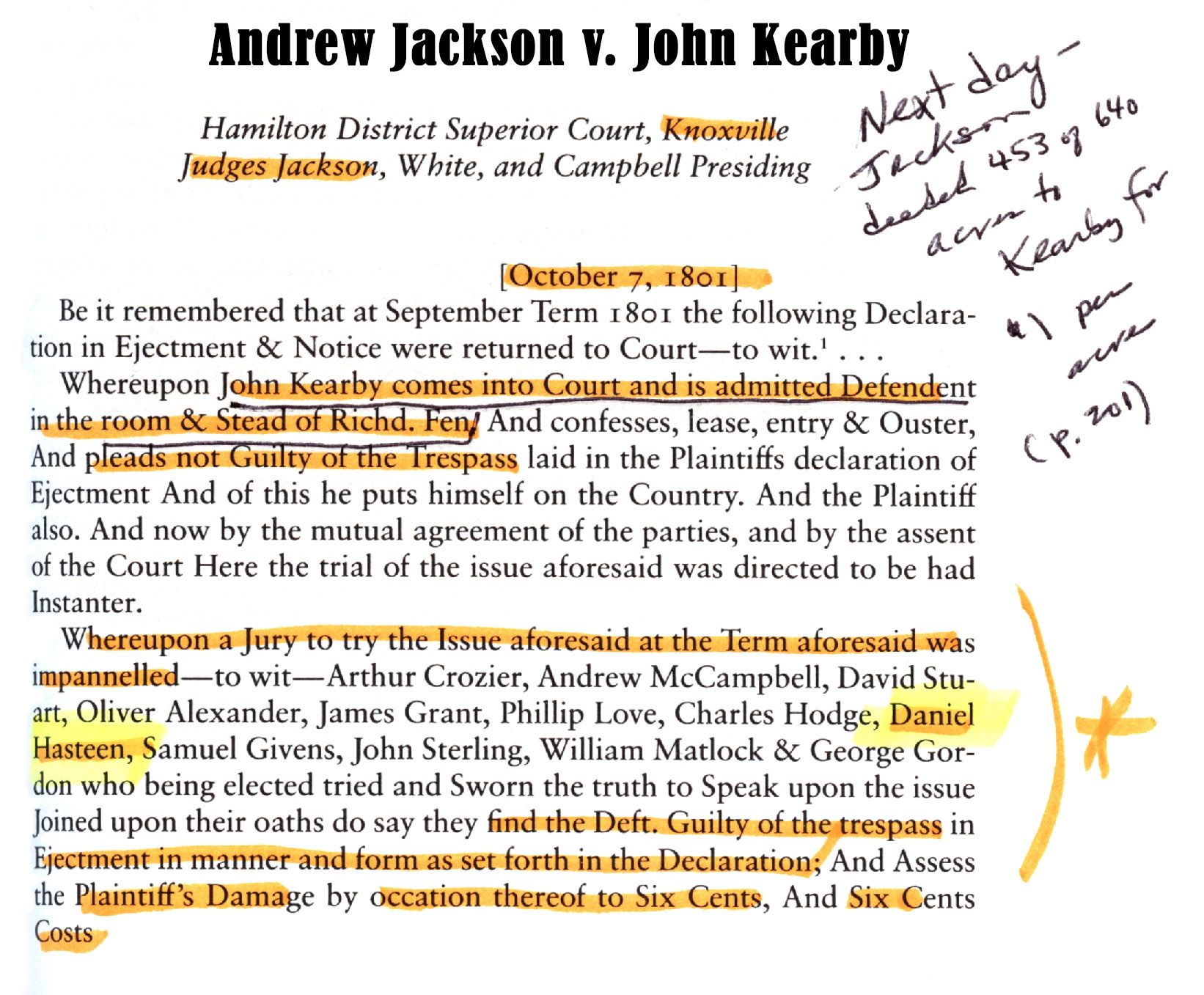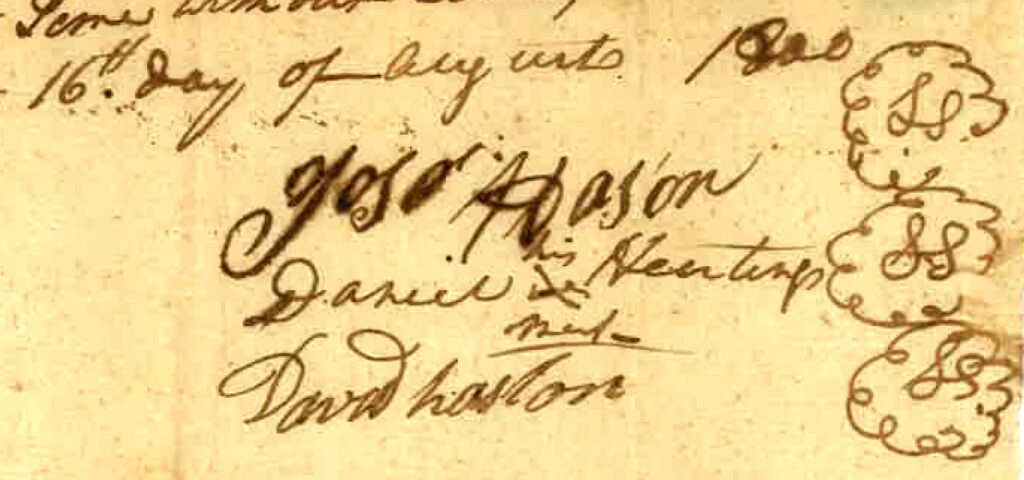26 - Daniel Haston's Many Experiences in the Courtroom
While Living in Knox County, TN

When Daniel was a young man back in Shenandoah County, VA, he was conspicuously absent from court appearances of any kind, although his brothers were there often as witnesses, involved in court cases, or even sometimes as attorneys. Daniel, as far as we know, never served on a jury in Virginia. When Daniel was in Washington County, NC/TN he may have served on one jury, but I’m not even sure about that juror. He might have been our Daniel’s nephew, who was also named Daniel.
But in Knox County, TN in just 6 years and 4 months Daniel served as a jury member in at least 69 court cases! He may have served on juries more than any other Knox County citizen during that period. Was he doing it for pay? No, at that time in Knox County there was no payment for jury duty!
In addition to jury duty–as we saw in the two previous posts, his sons David and Joseph were involved in a couple of court cases that proved to be insignificant. He was in court to support them. On other occasions, Daniel was a witness. He was an estate administrator. He was a defendant. In another case he put up a security bond for a friend.
Daniel's Most Significant Court Appearances
in Knox County, Tennessee
April 20, 1795 – John Mattox vs. John Stone (In debt)
The first for-sure documented date we have for Daniel Haston’s appearance in Knoxville is this Knox County case in which Daniel was a bondsman for a friend. Unfortunately for Daniel, his friend (apparently) deserted him, leaving Daniel financially responsible for the court costs and damages to be paid to the plaintiff.
[i] John Mattox vs. John Stone, Knox County, Tennessee Court of Pleas and Quarter Sessions, Docket 383/378, 1795-1797.
April 29, 1797 - John Stone vs. Daniel Hastings (Scire Facias)
Scire Facias = Judicial writ requiring a person to appear in court and argue why a judgment against him should not be annulled, vacated, executed, or enforced.
This case goes back to a choice Daniel made on April 20, 1795, when he signed to be the security for John Mattox who took John Stone, a local tavern owner, to court. It seems that Mattox may have fled the county to avoid paying damages and costs when he failed to prosecute his case against Stone and found himself in the role of defendant.
This April 29, 1797 John Stone vs. Daniel Hastings case was summarized in these words:
The Defendant having been duly warned and not appearing though solemnly called On motion of the Plaintiff by his Attorney It is considered by the Court that the Plaintiff may have Execution against the Defendant for Thirteen Dollars twenty four and one half cents the costs in the writ aforesaid specified and also that the Plaintiff recover against the said Defendant his costs by him expended in suing forth and prosecuting this writ.
Earlier, Daniel had been informed that he owed Stone $20.44½ and that he must return to court on April 24, 1797. That was a Monday. But when this case was presented on Saturday, April 29, 1797, it appears that Stone was willing to receive the lesser amount of $13.24½. Or perhaps Daniel had already paid $7.20, but still owed the $13.24½.
April 12, 1798 - State vs. David Hasten (T V A)
This was the “cow tails” case presented in a previous article. Trespass Vi et Armis = trespass with force and arms.
January 1800 – Appointed of Daniel Haston and Elizabeth Roddy as Estate Administrators
On motion of Elizabeth Roddy and Daniel Hastings Administrators is granted them on the estate of James Roddy deceased, who have been sworn, and entered into bond together with William Tipton and John Desmond (Jun.) in the sum of One Thousand Dollars with condition as law directs.[i]
[i] Knox County, Tennessee, Estate Settlements, Reel # 1 (Volume 1, July 1792 – October 1811), 74.
James Roddy, son of Philip Roddy, had married Elizabeth Haston in December 1793 in Washington County.
October 1800 - Samuel Cowan vs. Joseph Haston (T V A)
Trespass Vi et Armis = trespass with force and arms; quare clausum fregit = literally, “breaking a close” – meaning breaking a fence. This was the “Timothy lot” case mentioned in a previous article. The following signatures were

Joseph Haston, Daniel Hastings, and David Haston signed a $2,000 bond to assure that Joseph would appear in court on the second Monday (13th) of October at the courthouse in Knoxville to answer Samuel Cowan’s accusations. Joseph and David signed in their own handwriting, but Daniel made his mark. As we gave seen previously, Daniel could have signed his first name in English and his surname in German, but maybe that was not allowed in Knoxville.
October 7, 1801 - Hamilton District Court Case, Andrew Jackson vs. John Kearby
But one of the most interesting cases that Daniel was involved in was the Hamilton District Court Case, Andrew Jackson vs. John Kearby. Daniel was on the jury that heard and decided this case involving Andrew Jackson. OK, get this–Andrew Jackson was a litigant (he took Kearby to court). And Andrew Jackson was a judge on this case! Yep, he judged his own case! Daniel Haston and the other jury members ruled against Kearby and in favor of Andrew Jackson’s complaint! But they only assessed Kearby six cents in damages and six cents in court costs. See the image for more about this case. Yep – Daniel Haston was on a jury that tried a case involving a district court judge, who was a future War of 1812 hero and two-term President of the United States. See the image at the top of the page.
October 1801 - Nathaniel Hays vs. Solomon McCampbell and Paul Cunningham
On July 13, 1801, Daniel Haston was summoned to court in Knox County, Tennessee, along with John Cowan and James Cunningham. They were called to witness on behalf of the defendant, Paul Cunningham, who was accused of trespassing on and destroying the property of Nathaniel Hays. Sound familiar? The case focused on a dispute regarding the property boundaries of Hays and Cunningham.

Then it appears that Nathaniel Hays moved to Davidson County, Tennessee (near Nashville) before the trial was complete. On January 15, 1802 he appeared in court and stated that “he has some time ago removed himself and family to Cumberland [middle Tennessee, east Nashville area]…” Apparently, he had missed a court appearance, because of “owing to high waters which he has to cross he could not reach Knoxville till after the above cause was called for trial ….”
The Court dismissed the case and Hays was pressed to pay court costs. The sheriff of Knox County sent notices in July 1802 and April 1803 to the sheriff of Davidson County to recover the court costs from Nathaniel Hays.
The original document file contains a receipt for each of these men, signed by the recipients: July 9, 1804: William Haislet, Junior; July 9, 1804: William Haislet, Senior; December 29, 1804: John Cowan; August 6, 1806: James Cunningham.
There is no receipt, in the file, for Daniel Haston/Hasting. When compared to the Daniel Haston timeline for that era, it is possible or likely that Daniel Haston had moved to White County by the time payments were made. Who knows if he ever received his $1.50?

